How To Create Dataset In Asp Net
Repository Pattern Implementation in ASP.NET Core
![]()
In this post, I will show how to implement a generic repository pattern with asynchronous methods in an ASP.NET Core Web API. If you are not familiar with ASP.NET Core Web API, I recommend you read my How To Build a RESTful API with ASP.NET Core post first.

The API — MyMDB (My Movie Database) — will provide endpoints that perform CRUD operations on a database of movies and stars and it will be easy to extend for other types of features that can exist in a movie database.
I will use the following tools for the development:
- Visual Studio 2019 Community Edition (free)
- .Net Core SDK 2.2 (free)
- Microsoft SQL Server Express (free)
The sections of this post will be as follows:
- What is a Repository?
- Creating a Web API Project
- Adding a Model
- Adding a Controller (Movies)
- Implementing the Repository
- Adding a Base Controller
- Registering the Repository with the Dependency Injection System
- Creating Database using Migrations
- Testing
- Adding a New Model and a Controller (Stars)
What is a Repository?
Martin Fowler defines a repository here as below:
A Repository mediates between the domain and data mapping layers, acting like an in-memory domain object collection. Client objects construct query specifications declaratively and submit them to Repository for satisfaction. Objects can be added to and removed from the Repository, as they can from a simple collection of objects, and the mapping code encapsulated by the Repository will carry out the appropriate operations behind the scenes. Conceptually, a Repository encapsulates the set of objects persisted in a data store and the operations performed over them, providing a more object-oriented view of the persistence layer. Repository also supports the objective of achieving a clean separation and one-way dependency between the domain and data mapping layers.
Creating a Web API Project
Open Visual Studio and select Create a new project -> ASP.NET Core Web Application . Then, name the solution and the project.
In the next dialog, select the API template and ASP.NET Core version and then click Create.

The project structure at the beginning is as follows:
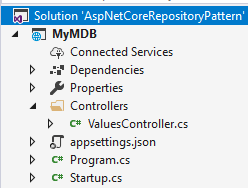
Adding a Model
In this section, we will add our first model class.
Add a new folder called Data to the project.
Then add IEntity interface to this folder as below:
Next, add Models folder to the project and add Movie class to this folder:
At this point, we need to build the project.
Adding a Controller
Right-click on the Controllers folder and select Add Controller -> API Conroller with actions, using Entity Framework.
Make the selections as following in the next dialog:
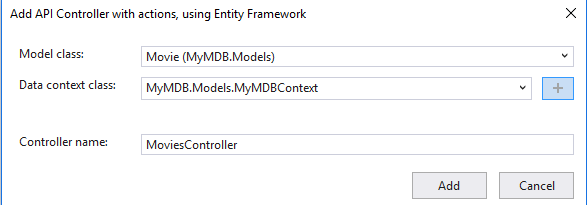
After scaffolding,
- MyMDBContext class is added into Data folder.
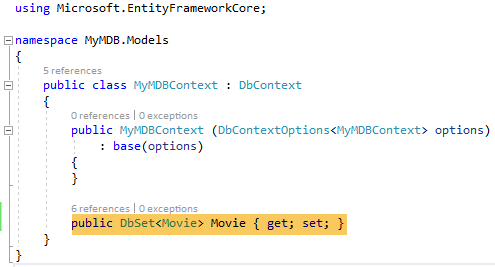
- Connection string for MyMDBContext is added to appsetting.json .
- MoviesController is created.
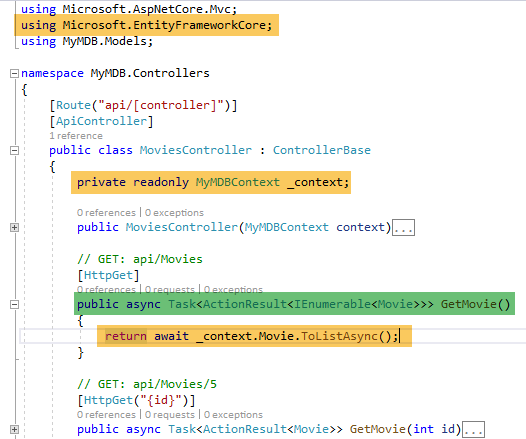
As you see, there is direct access to Entity Framework Core in MoviesController.
The relationship is as follows:
Controller -> EF Core -> SQL Server Now, we will add a repository between the controller and EF Core as an abstraction layer and will turn the relation into:
Controller -> Repository -> EF Core -> SQL Server Since the default behavior of the methods is asynchronous in the scaffolded API controller, we will create our methods in the repository as asynchronous too.
Implementing the Repository
Create IRepository interface under the Data folder with the following code:
This interface is planned to be an abstraction layer over different ORMs.
Now, we will create an abstract class for EF Core which implements this interface.
Create EFCore folder in the Data folder and add EfCoreRepository class here with the following code:
As you see, we moved the EF Core related code in the MoviesController to this class.
We should move MyMDBContext to the EFCore folder as it is specific to EF Core.
Next, we will create a concrete class which inherits EfCoreRepository.
Create a class called EfCoreMovieRepository in the EFCore folder with the following code:
Now, we can use this repository in MoviesController. To make things better, let's add a base controller to the project and inherit MoviesController from this base class.
Adding a Base Controller
Add MyMDBController as an abstract class to Controllers folder with the following code:
Update MoviesController with the following code:
Registering the Repository with the Dependency Injection System
MoviesController needs an object of type EfCoreMovieRepository in the constructor. We will register this repository to the dependency injection system and then DI system will provide this service to the MoviesController. Add the following highlighted line to the Startup.cs :
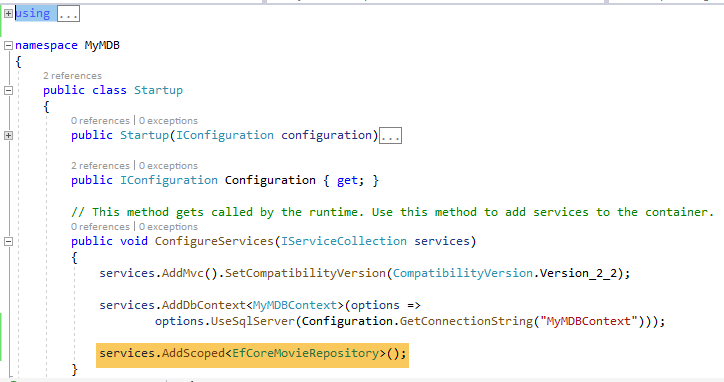
Creating Database using Migrations
Now, we will create the database using the EF Core Migrations feature.
Migrations lets us create a database that matches our data model and update the database schema when our data model changes.
Open Tools -> NuGet Package Manager > Package Manager Console(PMC) and run the following commands in the PMC:
Add-Migration Initial
Update-Database Now, we will check the database created. Open View -> SQL Server Object Explorer:

Testing
At this point, we should test our API endpoints. We can use Postman to test all methods and the browser to test the GET methods.
If you need help with testing, you can refer to the post that I mentioned above.
Here is a screenshot of one of my tests:

Adding a New Model and Controller
In this section, we will implement API endpoints which perform CRUD operations on a database of Stars. We will use the base repository and the controller that we implemented in the previous sections.
The steps will be as follows:
- Add Star model in the Models folder with the following code:
- Add EfCoreStarRepository class in the Data -> EFCore folder:
- Add StarsController in the Controllers folder with the following code:
- Add the following highlighted line to Startup.cs :
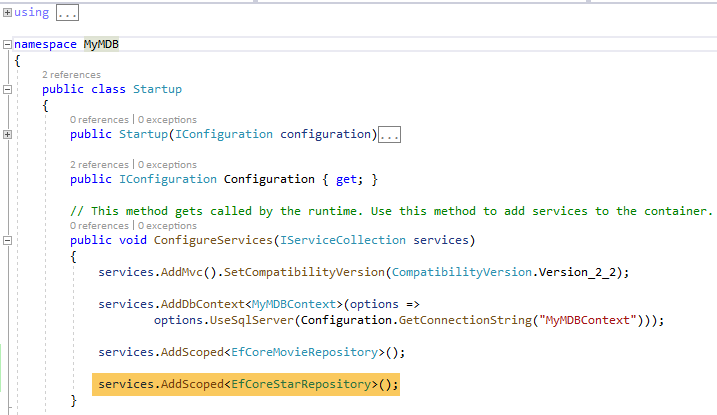
- Add the following highlighted line to MyMDBContext.cs :
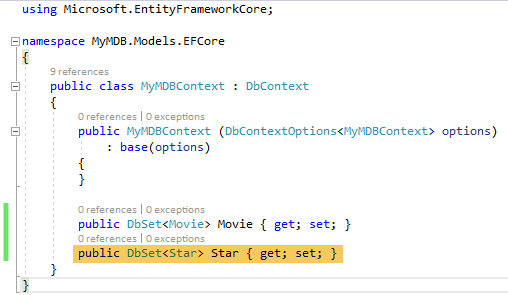
- Run the following commands in the PMC:
Add-Migration Star Update-Database
You can check the newly created table ( Star ) from SQL Server Object Explorer in Visual Studio.
Our final project structure is as follows:
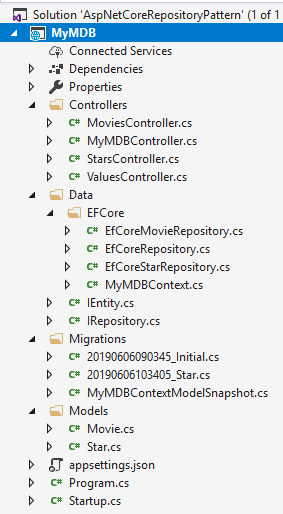
Now, you should test every endpoint to check if everything is OK. Below is a screenshot of one of my tests:
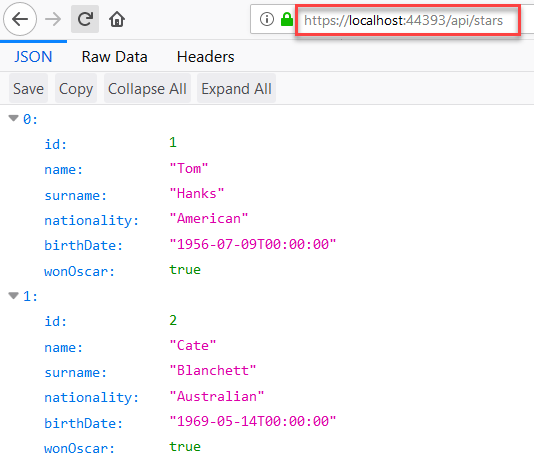
My intention on writing this last section was to show you how easy it is to extend this model to add new API endpoints for new features (TV Shows, video games… etc.) once we have the base repository and the controller.
You can find the full project in this GitHub repository.
How To Create Dataset In Asp Net
Source: https://medium.com/net-core/repository-pattern-implementation-in-asp-net-core-21e01c6664d7
Posted by: pullenmrseach.blogspot.com

0 Response to "How To Create Dataset In Asp Net"
Post a Comment